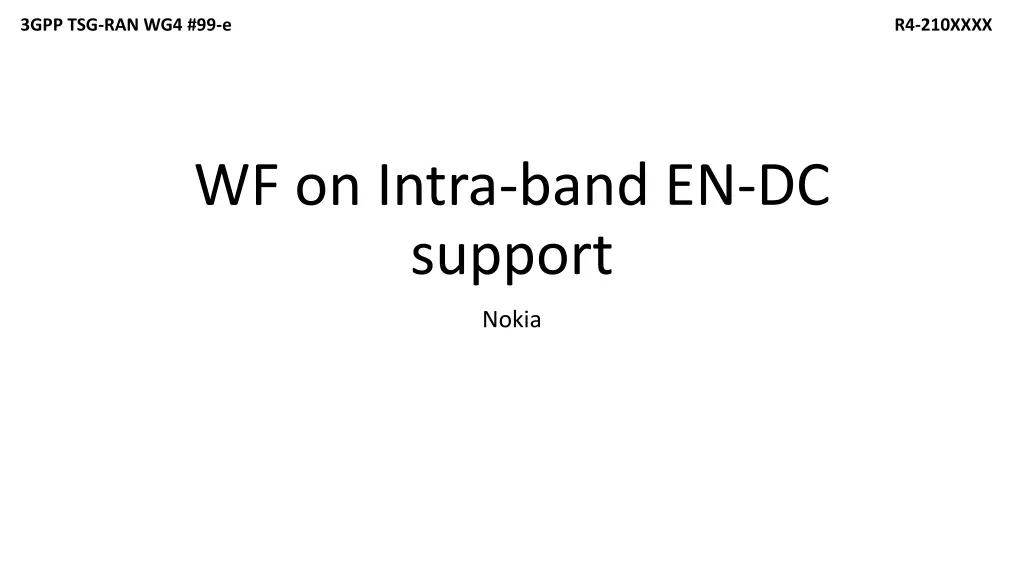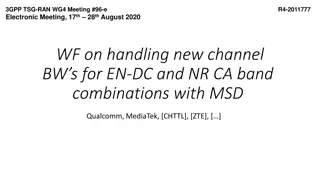
Intra-band EN-DC Support Options in 3GPP TSG-RAN WG4
Explore various options for intra-band EN-DC support discussed in 3GPP TSG-RAN WG4 #99-e, addressing contiguous and non-contiguous configurations. Options include signaling definitions, UE capability impacts, and fallback scenarios.
Uploaded on | 1 Views
Download Presentation

Please find below an Image/Link to download the presentation.
The content on the website is provided AS IS for your information and personal use only. It may not be sold, licensed, or shared on other websites without obtaining consent from the author. If you encounter any issues during the download, it is possible that the publisher has removed the file from their server.
You are allowed to download the files provided on this website for personal or commercial use, subject to the condition that they are used lawfully. All files are the property of their respective owners.
The content on the website is provided AS IS for your information and personal use only. It may not be sold, licensed, or shared on other websites without obtaining consent from the author.
E N D
Presentation Transcript
3GPP TSG-RAN WG4 #99-e R4-210XXXX WF on Intra-band EN-DC support Nokia
Issue 5 Issue 5- -1 1- -1: 1: intraBandENDC intraBandENDC- -Support definition Support definition Options discussed in RAN4#99e Option 1: For intra-band EN-DC, contiguous or non-contiguous is determined by the configuration between the primary cells from each cell group. (Apple, OPPO, [MTK]) Option 2: The entire LTE and NR spectrum are contiguous, i.e., all carriers are contiguously spaced for contiguous EN-DC. (Qualcomm, Nokia, [NTT Docomo?]) Option 2a: If separate UL/DL signaling is not available, then the lowest capability between UL and DL should be reported where the lowest capability is regarded as C-only. Some scenarios will not be able to be configured by the network. (Qualcomm) Option 2b: Not allowed only signaling non-contiguous for more than two carriers. Both must be signaled for all possible mixed configurations (Nokia) Option 3: If UE supports the case where one of LTE carriers is contiguous with one of NR carriers, UE needs to indicate contiguous EN-DC capability. If UE supports the case where one of LTE carriers is non-contiguous with one of NR carriers, UE needs to indicate non-contiguous EN-DC capability. If UE supports above both cases, UE needs to indicate both contiguous and non-contiguous EN-DC capability. The interpretation should be applied to both UL and DL. (NTT Docomo, Verizon, [Ericsson]) Option 4: IntraBandENDC-Support IE should be indicated in UL and DL separately per band combination. (Huawei, Qualcomm, Google) Option 5: Redefine DC_(n)48CA with UL DC_48A_n48A non-contiguous, DC_48A_(n)48AA with UL DC_(n)48AA contiguous not to violate fallback operation (Google, Apple) Option 6: CR R4-2109968 (Ericsson); the contiguous EN-DC sub-block consist of one E-UTRA and one NR sub-block of the EN-DC band class as specified in Table5.3B.0-1. Then intraBandENDC-Support is absent. For combinations of C and NC EN-DC (e.g. DC_48A-(n)48AA) there can be at most two NC EN-DC sub-blocks one of which is to the type in Table 5.3B.0-1, the other either an E-UTRA or an NR sub-block. For these the UE lists three sub-blocks with intraBandENDC-Support = both . This can also be indicated for two sub-blocks, e.g. DC_(n)48AA and DC_48A-n48. For NC combinations of E-UTRA and NR sub-blocks, there can be an arbitrary number of sub-blocks (each either E-UTRA or NR) when intraBandENDC-Support = non-contiguous . Way-forward for 5-1-1. See next page.
Issue 5 Issue 5- -1 1- -2: Impact to UE capability signaling 2: Impact to UE capability signaling Options discussed in RAN4#99e Option 1: Ask RAN2 to introduce or modify UE capability signaling. (Huawei, Qualcomm, [OPPO]) Option 1a: Change needed from Rel-15. (Huawei) Option 1b: Keep Rel-15 signaling. Introduce enhancement from Rel-16. ([MTK]) Option 2: No new signaling is needed (Apple, Google, OPPO, DOCOMO, [MTK], [Nokia]) Option 2a: Some clarification of existing signaling may be needed in RAN2. (Verizon, Google) Option 2b: No change at all to RAN2 is needed. (Ericsson) Way-forward on 5-1-1 and 5-1-2 Further study the following options for the options. Apple CR (R4-2110155/R4-2110156) without changing UE capability signaling Ericsson CR (Revision of R4-2109968) without changing UE capability signaling Nokia CR (R4-2109782) without changing UE capability signaling Huawei proposal (R4-2111353) without changing RAN4 spec. Ask RAN2 to introduce a UE capability to indicate contiguous/non-contiguous EN-DC separately for UL from DL.
Issue 5 Issue 5- -1 1- -3: Fallback from C to NC and NC to C. 3: Fallback from C to NC and NC to C. Options discussed in RAN4#99e Option 1: Fallback from C to NC is not required but NC to C is required. (Qualcomm, Apple, OPPO) Option 2: None of cross C-NC fallbacks is required. (Verizon) Option 3: It depends on UE capability. Option 3a: UE capable of both C and NC can support the fallback from C to NC, as well as from NC to C. Option 3b: others Option 4: Removing RAN2 38.306 fall back restriction might be needed. ([OPPO]) Option 5: No need to make any change to 38.306 (Ericsson, MTK, Huawei, [Nokia]) Way-Forward on 5-1-3 No change is expected regarding An intra-band non-contiguous band combination is not considered to be a fallback band combination of an intra-band contiguous band combination. in TS 38.306.
Issue 5 Issue 5- -1 1- -4: UE RF requirement update 4: UE RF requirement update Options discussed in RAN4#99e Option 1: The UE RF requirements for intra-band contiguous and non- contiguous EN-DC should be updated to reflect the possibility of intra-band contiguous or non-contiguous CA within the E-UTRA and/or NR cell group. (Qualcomm, Apple) Option 2: UE RF requirement change is not required. Way-Forward on 5-1-4 The proponents are encouraged to provide the spec impacts (i.e., in a form of a CR) for further review.
Issue 5 Issue 5- -1 1- -5: BCS issue 5: BCS issue Proposals Option 1: The same BCS shall be applied between contiguous and non- contiguous EN-DC. (Nokia) Option 2: Others Way-Forward on 5-1-5 No action. Already solved in RAN2 (R4-2107617)



